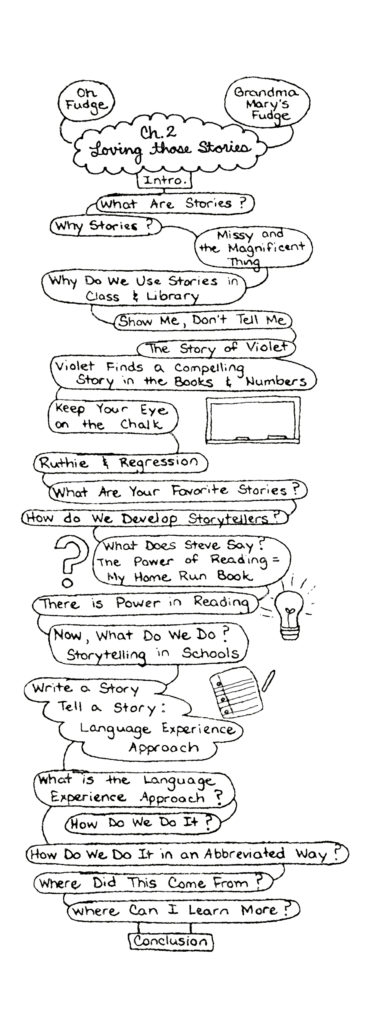Hi WinkWorld Readers,
I am still sitting here working on copy edits and sharing a bit as I go.
Here is a glimpse of Chapter Two, Loving Those Stories, from forthcoming The Power of Story from Libraries Unlimited ABC-CLIO.
a)First, I want to share an image from Katie Knox.
b)Next I want to share the visual Table of Contents from Missy Urbaniak for chapter two. Thanks, Missy.
c)An example of a story from chapter two.
Linda Huff, a teacher librarian in TX, shared this story with me. I hope you enjoy. I particularly like the very last part, where Linda is speaking of how her grandfather learned English. Happy Reading.
If you are here, with this paper now, with your coffee, at your breakfast table, in your armchair, or on your coffee break, taking time out to read, you already value one of the fundamental pillars of culture—reading.
As our days are getting shorter and the weather is pushing us indoors, we look for ways to occupy and entertain ourselves. It is true, that most often, we are at the Red Box looking for the next blockbuster movie, or browsing Netflix or Amazon for a title that matches our mood, but allow me to defend reading for a moment.
There is power in reading! As an elementary school teacher, I am fortunate to be part of the bustling library at the center of our school. Two years ago, I was able to attend a seminar on English Language Learners. The keynote speaker, Stephen Krashen, a guru on language acquisition, summed up a very inspiring conversation by saying, “If you want language success in all areas of academic learning, foster a love a reading in your students.”
So, with the support of an administration that is willing to explore all avenues of learning, our English as a Second Language (ESL) classes are now centered in the library. Just being among books and reading for the fun of it has helped transform our ELL students. Our students are becoming more verbal, confident, and their reading levels are burgeoning, as their language development is steadily progressing. Mostly though, they enjoy reading.
At the end of October, our school invited parents to come in to visit with their students’ teachers during Parent-Teacher Conference Day. I sat in on several of these conferences and discovered a recurring issue. Students who struggled in reading comprehension also struggled with math word problems. They were able to calculate math problems, but had difficulty in setting up the calculations found in word form.
I hypothesized that this is a comprehension problem, an issue with reading. As with math, science and social studies texts require higher levels of reading comprehension. These core subjects require a higher level of reading abilities.
Teachers do a great job with reinforcing conceptual learning and exposing students to a variety of strategies for learning across the curriculum. The student who is reading on grade level is always more able to grasp these concepts because they are not hindered by reading comprehension.
At the conclusion of parent conferences, we encouraged parents to have their children spend more time reading, with the reminder that reading well has the power to transform.
My own parents are first-generation Italians, and were educated in New York at a time when English as a Second Language did not exist. In New York in the 1930s, practically everyone was a second language learner. My mother reminisces about seeing my grandfather return from work every night with a newspaper, which he used as his ESL instruction. Reading with frequency worked. It still does!
One to chapter three for me. I’ll be back when finished.








